Financial Accounting Report: Client Transactions and Analysis
VerifiedAdded on 2021/02/19
|21
|5902
|57
Report
AI Summary
This report delves into the core principles of financial accounting, providing a comprehensive analysis of its purpose, stakeholders, and practical applications. It examines financial reporting procedures, emphasizing the importance of accurate record-keeping for internal and external stakeholders. The report includes detailed examples of journal entries, cash books, and nominal ledgers, illustrating how financial transactions are recorded and managed. Client case studies are presented to demonstrate the application of these concepts in real-world scenarios. Furthermore, the report explains the purpose of bank reconciliation statements, the reasons for discrepancies between cash book and bank statements, and the use of imprest systems. It also covers the reconciliation process for control accounts and explores the features of suspense accounts. Overall, the report provides a thorough understanding of financial accounting practices, including the preparation and interpretation of financial statements. The report includes solved assignments to aid understanding.
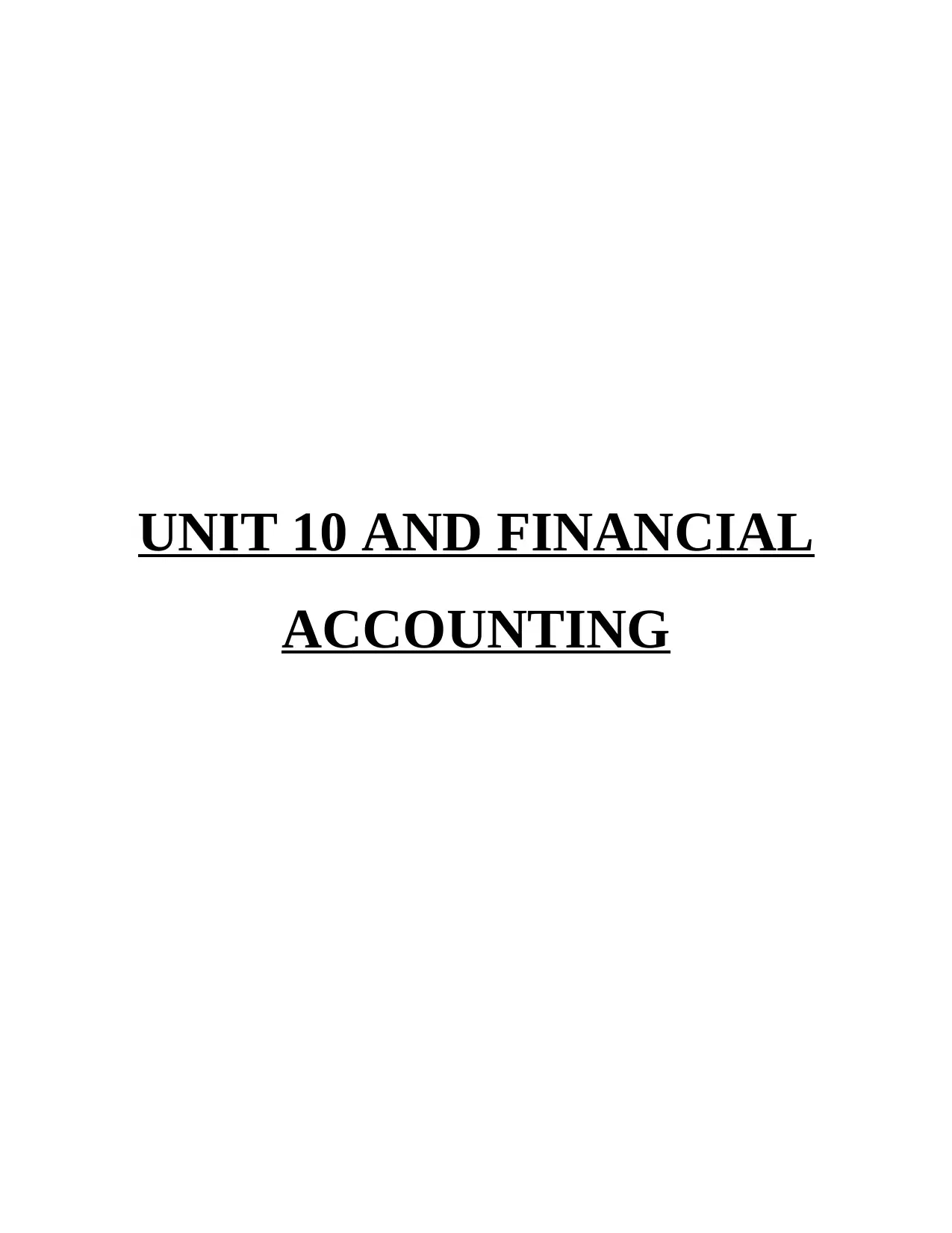
UNIT 10 AND FINANCIAL
ACCOUNTING
ACCOUNTING
Paraphrase This Document
Need a fresh take? Get an instant paraphrase of this document with our AI Paraphraser
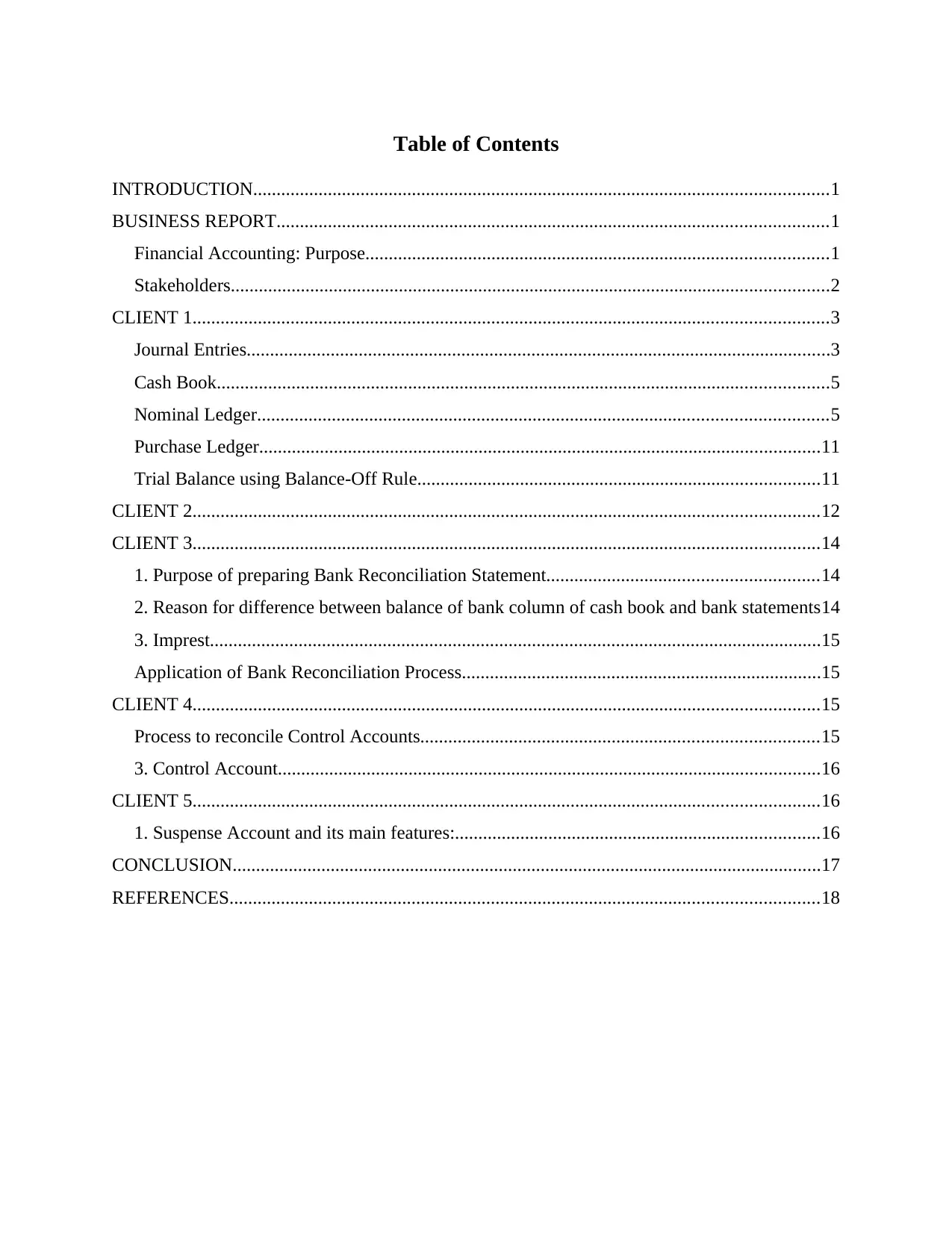
Table of Contents
INTRODUCTION...........................................................................................................................1
BUSINESS REPORT......................................................................................................................1
Financial Accounting: Purpose...................................................................................................1
Stakeholders................................................................................................................................2
CLIENT 1........................................................................................................................................3
Journal Entries.............................................................................................................................3
Cash Book...................................................................................................................................5
Nominal Ledger..........................................................................................................................5
Purchase Ledger........................................................................................................................11
Trial Balance using Balance-Off Rule......................................................................................11
CLIENT 2......................................................................................................................................12
CLIENT 3......................................................................................................................................14
1. Purpose of preparing Bank Reconciliation Statement..........................................................14
2. Reason for difference between balance of bank column of cash book and bank statements14
3. Imprest...................................................................................................................................15
Application of Bank Reconciliation Process.............................................................................15
CLIENT 4......................................................................................................................................15
Process to reconcile Control Accounts.....................................................................................15
3. Control Account....................................................................................................................16
CLIENT 5......................................................................................................................................16
1. Suspense Account and its main features:..............................................................................16
CONCLUSION..............................................................................................................................17
REFERENCES..............................................................................................................................18
INTRODUCTION...........................................................................................................................1
BUSINESS REPORT......................................................................................................................1
Financial Accounting: Purpose...................................................................................................1
Stakeholders................................................................................................................................2
CLIENT 1........................................................................................................................................3
Journal Entries.............................................................................................................................3
Cash Book...................................................................................................................................5
Nominal Ledger..........................................................................................................................5
Purchase Ledger........................................................................................................................11
Trial Balance using Balance-Off Rule......................................................................................11
CLIENT 2......................................................................................................................................12
CLIENT 3......................................................................................................................................14
1. Purpose of preparing Bank Reconciliation Statement..........................................................14
2. Reason for difference between balance of bank column of cash book and bank statements14
3. Imprest...................................................................................................................................15
Application of Bank Reconciliation Process.............................................................................15
CLIENT 4......................................................................................................................................15
Process to reconcile Control Accounts.....................................................................................15
3. Control Account....................................................................................................................16
CLIENT 5......................................................................................................................................16
1. Suspense Account and its main features:..............................................................................16
CONCLUSION..............................................................................................................................17
REFERENCES..............................................................................................................................18
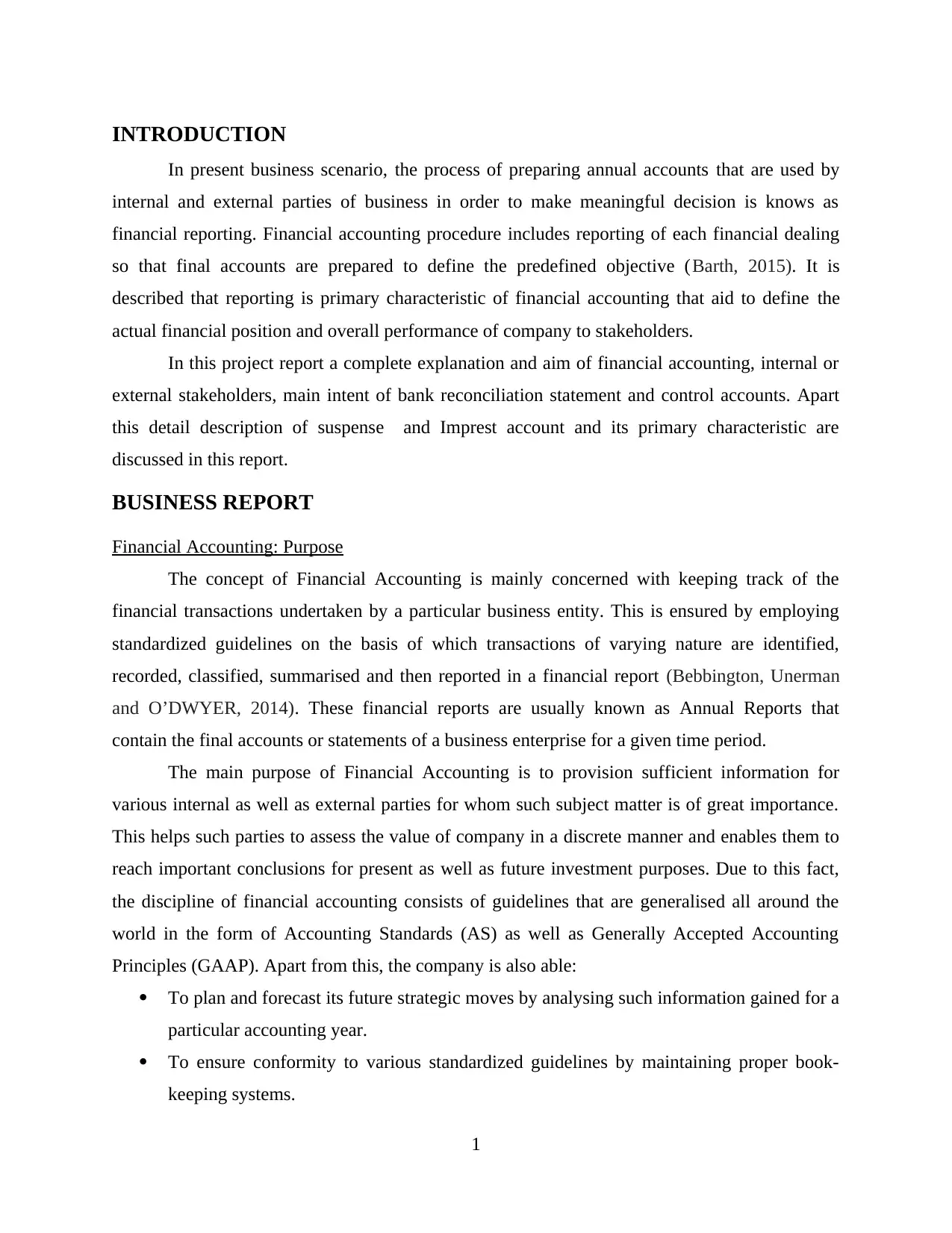
INTRODUCTION
In present business scenario, the process of preparing annual accounts that are used by
internal and external parties of business in order to make meaningful decision is knows as
financial reporting. Financial accounting procedure includes reporting of each financial dealing
so that final accounts are prepared to define the predefined objective (Barth, 2015). It is
described that reporting is primary characteristic of financial accounting that aid to define the
actual financial position and overall performance of company to stakeholders.
In this project report a complete explanation and aim of financial accounting, internal or
external stakeholders, main intent of bank reconciliation statement and control accounts. Apart
this detail description of suspense and Imprest account and its primary characteristic are
discussed in this report.
BUSINESS REPORT
Financial Accounting: Purpose
The concept of Financial Accounting is mainly concerned with keeping track of the
financial transactions undertaken by a particular business entity. This is ensured by employing
standardized guidelines on the basis of which transactions of varying nature are identified,
recorded, classified, summarised and then reported in a financial report (Bebbington, Unerman
and O’DWYER, 2014). These financial reports are usually known as Annual Reports that
contain the final accounts or statements of a business enterprise for a given time period.
The main purpose of Financial Accounting is to provision sufficient information for
various internal as well as external parties for whom such subject matter is of great importance.
This helps such parties to assess the value of company in a discrete manner and enables them to
reach important conclusions for present as well as future investment purposes. Due to this fact,
the discipline of financial accounting consists of guidelines that are generalised all around the
world in the form of Accounting Standards (AS) as well as Generally Accepted Accounting
Principles (GAAP). Apart from this, the company is also able:
To plan and forecast its future strategic moves by analysing such information gained for a
particular accounting year.
To ensure conformity to various standardized guidelines by maintaining proper book-
keeping systems.
1
In present business scenario, the process of preparing annual accounts that are used by
internal and external parties of business in order to make meaningful decision is knows as
financial reporting. Financial accounting procedure includes reporting of each financial dealing
so that final accounts are prepared to define the predefined objective (Barth, 2015). It is
described that reporting is primary characteristic of financial accounting that aid to define the
actual financial position and overall performance of company to stakeholders.
In this project report a complete explanation and aim of financial accounting, internal or
external stakeholders, main intent of bank reconciliation statement and control accounts. Apart
this detail description of suspense and Imprest account and its primary characteristic are
discussed in this report.
BUSINESS REPORT
Financial Accounting: Purpose
The concept of Financial Accounting is mainly concerned with keeping track of the
financial transactions undertaken by a particular business entity. This is ensured by employing
standardized guidelines on the basis of which transactions of varying nature are identified,
recorded, classified, summarised and then reported in a financial report (Bebbington, Unerman
and O’DWYER, 2014). These financial reports are usually known as Annual Reports that
contain the final accounts or statements of a business enterprise for a given time period.
The main purpose of Financial Accounting is to provision sufficient information for
various internal as well as external parties for whom such subject matter is of great importance.
This helps such parties to assess the value of company in a discrete manner and enables them to
reach important conclusions for present as well as future investment purposes. Due to this fact,
the discipline of financial accounting consists of guidelines that are generalised all around the
world in the form of Accounting Standards (AS) as well as Generally Accepted Accounting
Principles (GAAP). Apart from this, the company is also able:
To plan and forecast its future strategic moves by analysing such information gained for a
particular accounting year.
To ensure conformity to various standardized guidelines by maintaining proper book-
keeping systems.
1
⊘ This is a preview!⊘
Do you want full access?
Subscribe today to unlock all pages.

Trusted by 1+ million students worldwide
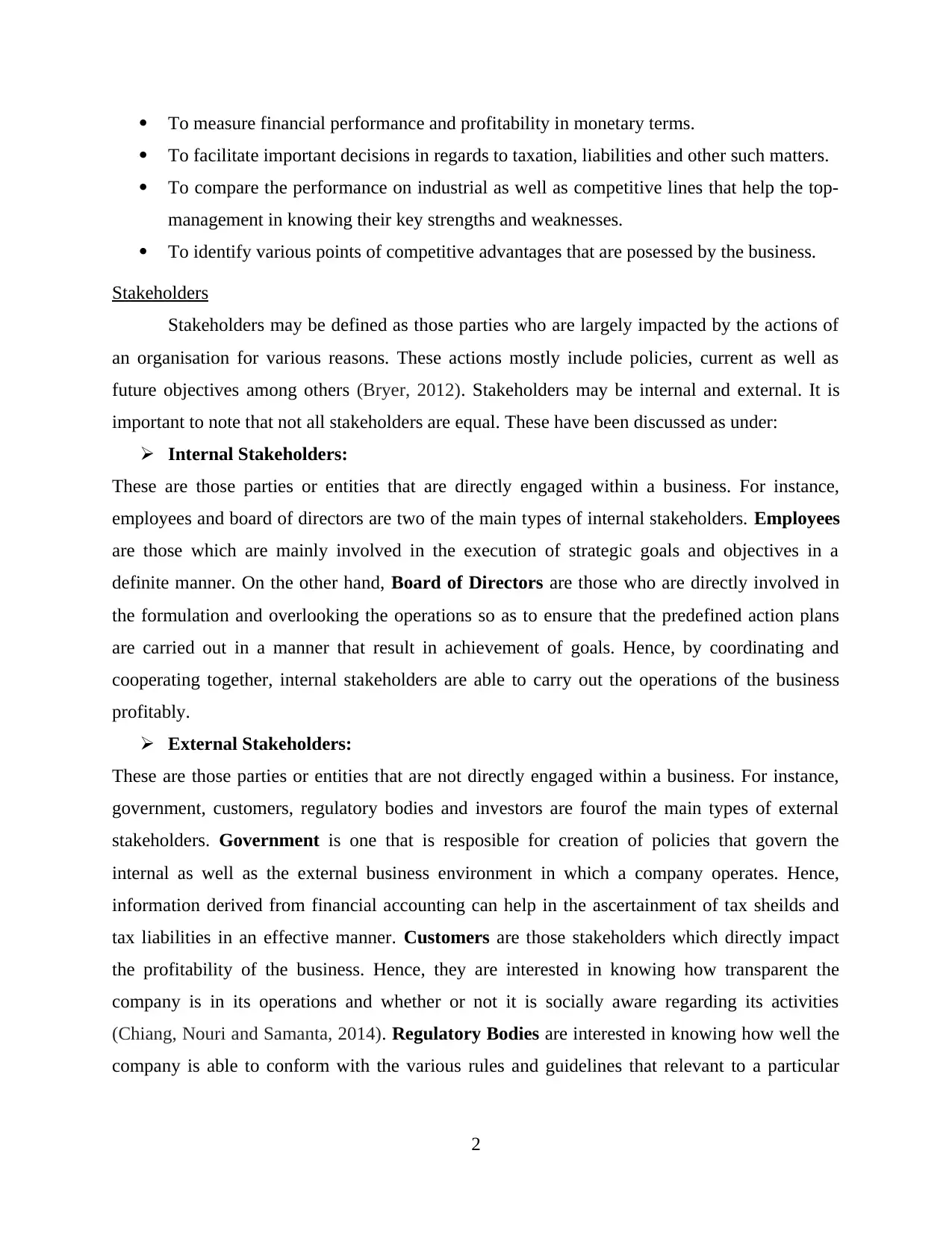
To measure financial performance and profitability in monetary terms.
To facilitate important decisions in regards to taxation, liabilities and other such matters.
To compare the performance on industrial as well as competitive lines that help the top-
management in knowing their key strengths and weaknesses.
To identify various points of competitive advantages that are posessed by the business.
Stakeholders
Stakeholders may be defined as those parties who are largely impacted by the actions of
an organisation for various reasons. These actions mostly include policies, current as well as
future objectives among others (Bryer, 2012). Stakeholders may be internal and external. It is
important to note that not all stakeholders are equal. These have been discussed as under:
Internal Stakeholders:
These are those parties or entities that are directly engaged within a business. For instance,
employees and board of directors are two of the main types of internal stakeholders. Employees
are those which are mainly involved in the execution of strategic goals and objectives in a
definite manner. On the other hand, Board of Directors are those who are directly involved in
the formulation and overlooking the operations so as to ensure that the predefined action plans
are carried out in a manner that result in achievement of goals. Hence, by coordinating and
cooperating together, internal stakeholders are able to carry out the operations of the business
profitably.
External Stakeholders:
These are those parties or entities that are not directly engaged within a business. For instance,
government, customers, regulatory bodies and investors are fourof the main types of external
stakeholders. Government is one that is resposible for creation of policies that govern the
internal as well as the external business environment in which a company operates. Hence,
information derived from financial accounting can help in the ascertainment of tax sheilds and
tax liabilities in an effective manner. Customers are those stakeholders which directly impact
the profitability of the business. Hence, they are interested in knowing how transparent the
company is in its operations and whether or not it is socially aware regarding its activities
(Chiang, Nouri and Samanta, 2014). Regulatory Bodies are interested in knowing how well the
company is able to conform with the various rules and guidelines that relevant to a particular
2
To facilitate important decisions in regards to taxation, liabilities and other such matters.
To compare the performance on industrial as well as competitive lines that help the top-
management in knowing their key strengths and weaknesses.
To identify various points of competitive advantages that are posessed by the business.
Stakeholders
Stakeholders may be defined as those parties who are largely impacted by the actions of
an organisation for various reasons. These actions mostly include policies, current as well as
future objectives among others (Bryer, 2012). Stakeholders may be internal and external. It is
important to note that not all stakeholders are equal. These have been discussed as under:
Internal Stakeholders:
These are those parties or entities that are directly engaged within a business. For instance,
employees and board of directors are two of the main types of internal stakeholders. Employees
are those which are mainly involved in the execution of strategic goals and objectives in a
definite manner. On the other hand, Board of Directors are those who are directly involved in
the formulation and overlooking the operations so as to ensure that the predefined action plans
are carried out in a manner that result in achievement of goals. Hence, by coordinating and
cooperating together, internal stakeholders are able to carry out the operations of the business
profitably.
External Stakeholders:
These are those parties or entities that are not directly engaged within a business. For instance,
government, customers, regulatory bodies and investors are fourof the main types of external
stakeholders. Government is one that is resposible for creation of policies that govern the
internal as well as the external business environment in which a company operates. Hence,
information derived from financial accounting can help in the ascertainment of tax sheilds and
tax liabilities in an effective manner. Customers are those stakeholders which directly impact
the profitability of the business. Hence, they are interested in knowing how transparent the
company is in its operations and whether or not it is socially aware regarding its activities
(Chiang, Nouri and Samanta, 2014). Regulatory Bodies are interested in knowing how well the
company is able to conform with the various rules and guidelines that relevant to a particular
2
Paraphrase This Document
Need a fresh take? Get an instant paraphrase of this document with our AI Paraphraser
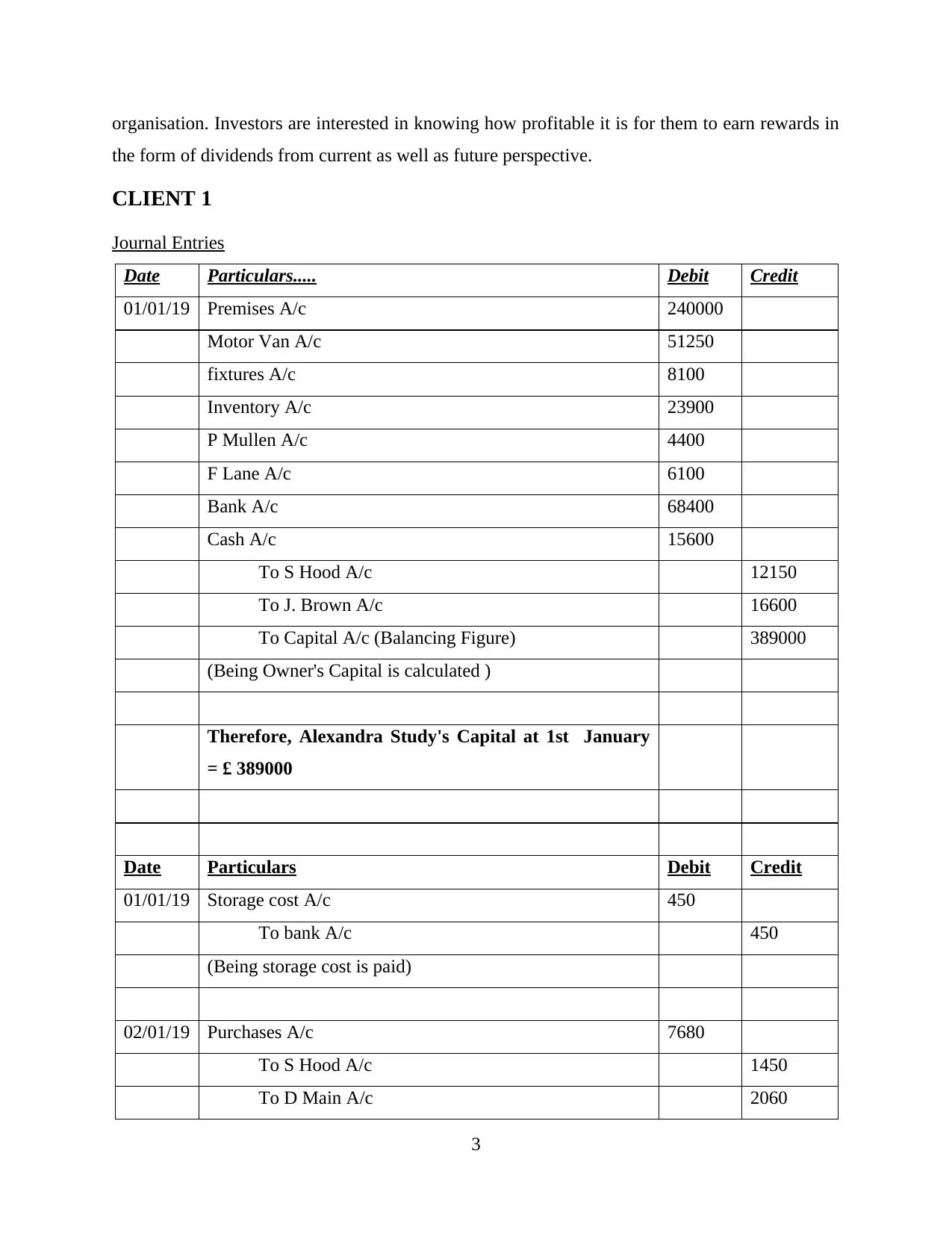
organisation. Investors are interested in knowing how profitable it is for them to earn rewards in
the form of dividends from current as well as future perspective.
CLIENT 1
Journal Entries
Date Particulars..... Debit Credit
01/01/19 Premises A/c 240000
Motor Van A/c 51250
fixtures A/c 8100
Inventory A/c 23900
P Mullen A/c 4400
F Lane A/c 6100
Bank A/c 68400
Cash A/c 15600
To S Hood A/c 12150
To J. Brown A/c 16600
To Capital A/c (Balancing Figure) 389000
(Being Owner's Capital is calculated )
Therefore, Alexandra Study's Capital at 1st January
= £ 389000
Date Particulars Debit Credit
01/01/19 Storage cost A/c 450
To bank A/c 450
(Being storage cost is paid)
02/01/19 Purchases A/c 7680
To S Hood A/c 1450
To D Main A/c 2060
3
the form of dividends from current as well as future perspective.
CLIENT 1
Journal Entries
Date Particulars..... Debit Credit
01/01/19 Premises A/c 240000
Motor Van A/c 51250
fixtures A/c 8100
Inventory A/c 23900
P Mullen A/c 4400
F Lane A/c 6100
Bank A/c 68400
Cash A/c 15600
To S Hood A/c 12150
To J. Brown A/c 16600
To Capital A/c (Balancing Figure) 389000
(Being Owner's Capital is calculated )
Therefore, Alexandra Study's Capital at 1st January
= £ 389000
Date Particulars Debit Credit
01/01/19 Storage cost A/c 450
To bank A/c 450
(Being storage cost is paid)
02/01/19 Purchases A/c 7680
To S Hood A/c 1450
To D Main A/c 2060
3
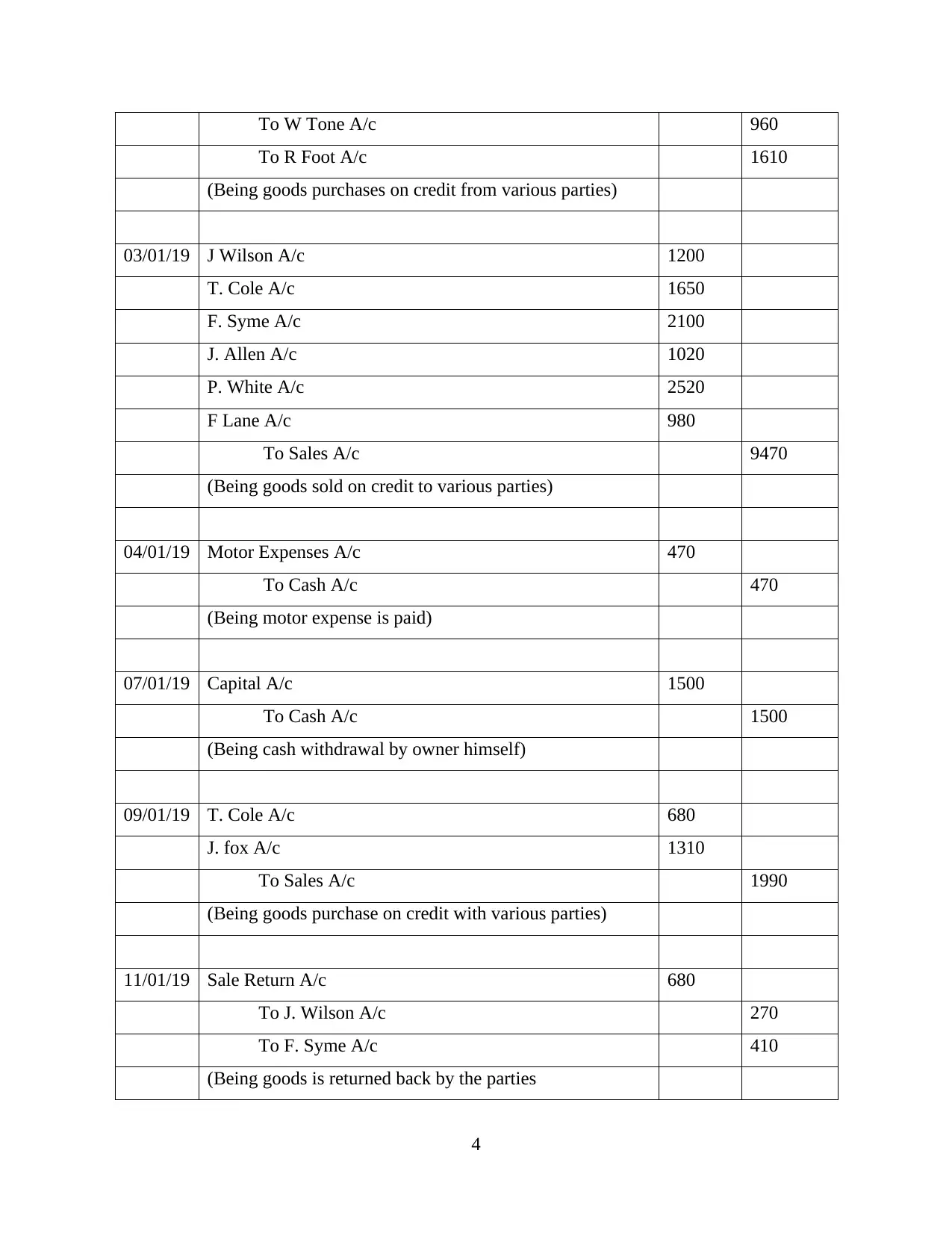
To W Tone A/c 960
To R Foot A/c 1610
(Being goods purchases on credit from various parties)
03/01/19 J Wilson A/c 1200
T. Cole A/c 1650
F. Syme A/c 2100
J. Allen A/c 1020
P. White A/c 2520
F Lane A/c 980
To Sales A/c 9470
(Being goods sold on credit to various parties)
04/01/19 Motor Expenses A/c 470
To Cash A/c 470
(Being motor expense is paid)
07/01/19 Capital A/c 1500
To Cash A/c 1500
(Being cash withdrawal by owner himself)
09/01/19 T. Cole A/c 680
J. fox A/c 1310
To Sales A/c 1990
(Being goods purchase on credit with various parties)
11/01/19 Sale Return A/c 680
To J. Wilson A/c 270
To F. Syme A/c 410
(Being goods is returned back by the parties
4
To R Foot A/c 1610
(Being goods purchases on credit from various parties)
03/01/19 J Wilson A/c 1200
T. Cole A/c 1650
F. Syme A/c 2100
J. Allen A/c 1020
P. White A/c 2520
F Lane A/c 980
To Sales A/c 9470
(Being goods sold on credit to various parties)
04/01/19 Motor Expenses A/c 470
To Cash A/c 470
(Being motor expense is paid)
07/01/19 Capital A/c 1500
To Cash A/c 1500
(Being cash withdrawal by owner himself)
09/01/19 T. Cole A/c 680
J. fox A/c 1310
To Sales A/c 1990
(Being goods purchase on credit with various parties)
11/01/19 Sale Return A/c 680
To J. Wilson A/c 270
To F. Syme A/c 410
(Being goods is returned back by the parties
4
⊘ This is a preview!⊘
Do you want full access?
Subscribe today to unlock all pages.

Trusted by 1+ million students worldwide
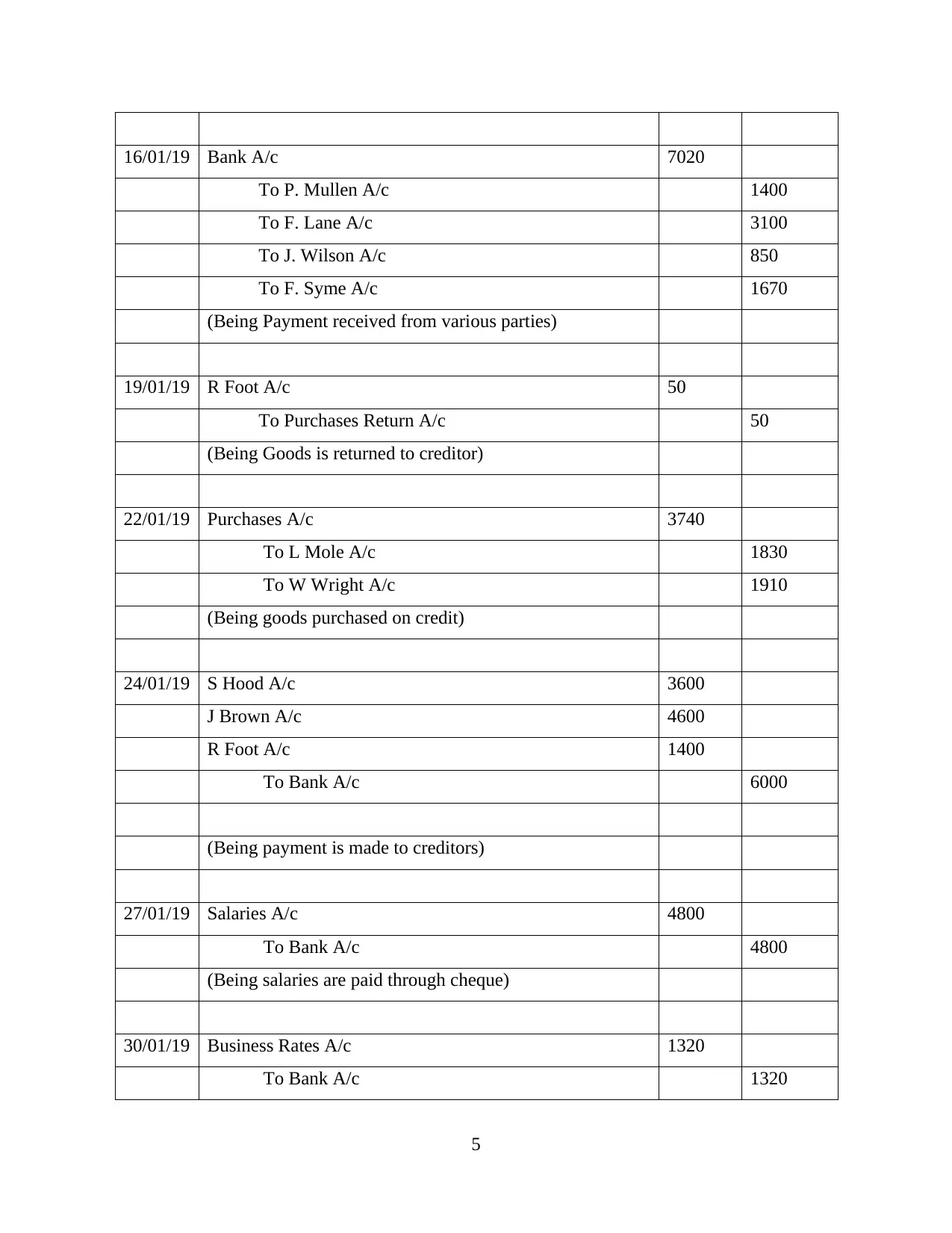
16/01/19 Bank A/c 7020
To P. Mullen A/c 1400
To F. Lane A/c 3100
To J. Wilson A/c 850
To F. Syme A/c 1670
(Being Payment received from various parties)
19/01/19 R Foot A/c 50
To Purchases Return A/c 50
(Being Goods is returned to creditor)
22/01/19 Purchases A/c 3740
To L Mole A/c 1830
To W Wright A/c 1910
(Being goods purchased on credit)
24/01/19 S Hood A/c 3600
J Brown A/c 4600
R Foot A/c 1400
To Bank A/c 6000
(Being payment is made to creditors)
27/01/19 Salaries A/c 4800
To Bank A/c 4800
(Being salaries are paid through cheque)
30/01/19 Business Rates A/c 1320
To Bank A/c 1320
5
To P. Mullen A/c 1400
To F. Lane A/c 3100
To J. Wilson A/c 850
To F. Syme A/c 1670
(Being Payment received from various parties)
19/01/19 R Foot A/c 50
To Purchases Return A/c 50
(Being Goods is returned to creditor)
22/01/19 Purchases A/c 3740
To L Mole A/c 1830
To W Wright A/c 1910
(Being goods purchased on credit)
24/01/19 S Hood A/c 3600
J Brown A/c 4600
R Foot A/c 1400
To Bank A/c 6000
(Being payment is made to creditors)
27/01/19 Salaries A/c 4800
To Bank A/c 4800
(Being salaries are paid through cheque)
30/01/19 Business Rates A/c 1320
To Bank A/c 1320
5
Paraphrase This Document
Need a fresh take? Get an instant paraphrase of this document with our AI Paraphraser
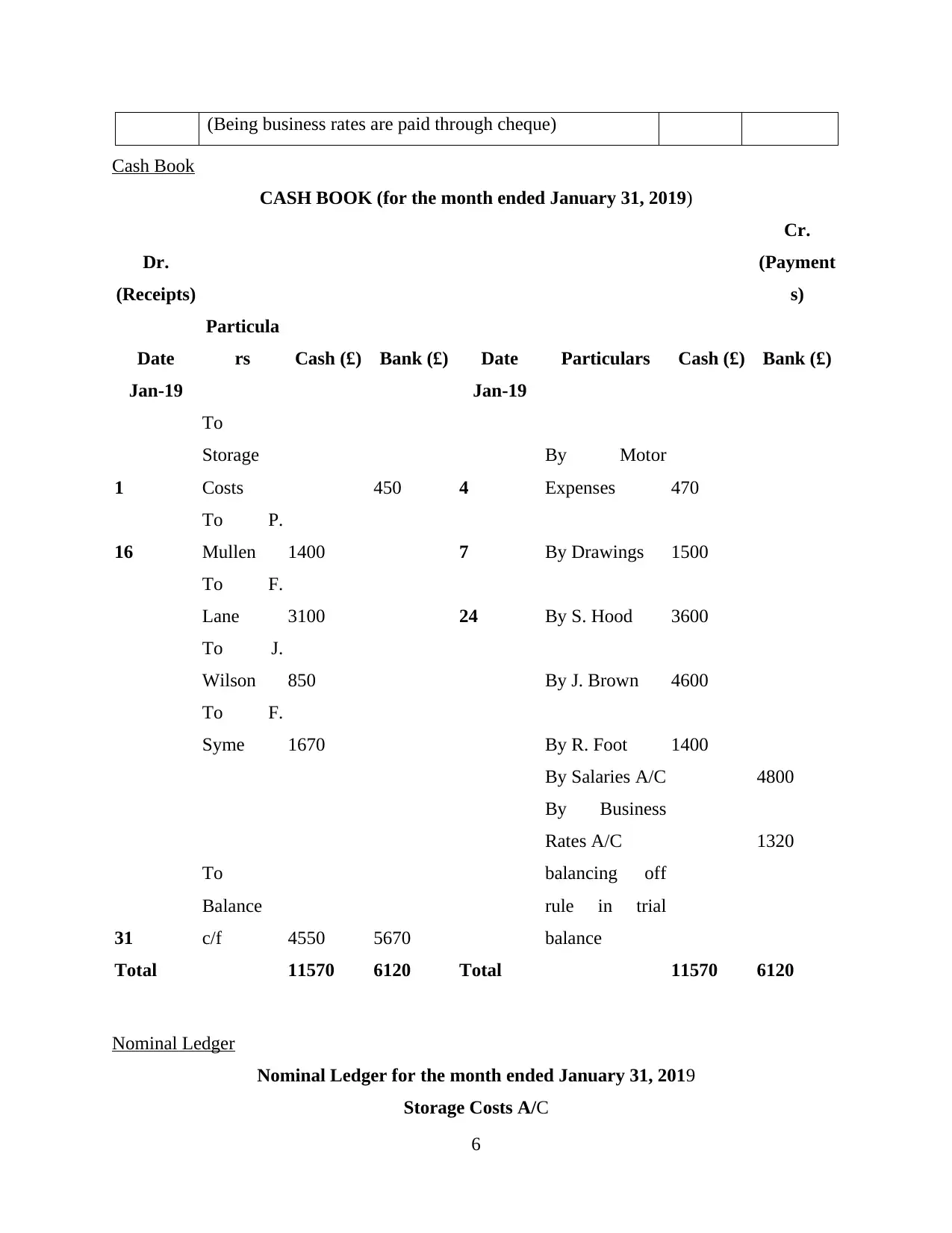
(Being business rates are paid through cheque)
Cash Book
CASH BOOK (for the month ended January 31, 2019)
Dr.
(Receipts)
Cr.
(Payment
s)
Date
Particula
rs Cash (£) Bank (£) Date Particulars Cash (£) Bank (£)
Jan-19 Jan-19
1
To
Storage
Costs 450 4
By Motor
Expenses 470
16
To P.
Mullen 1400 7 By Drawings 1500
To F.
Lane 3100 24 By S. Hood 3600
To J.
Wilson 850 By J. Brown 4600
To F.
Syme 1670 By R. Foot 1400
By Salaries A/C 4800
By Business
Rates A/C 1320
31
To
Balance
c/f 4550 5670
balancing off
rule in trial
balance
Total 11570 6120 Total 11570 6120
Nominal Ledger
Nominal Ledger for the month ended January 31, 2019
Storage Costs A/C
6
Cash Book
CASH BOOK (for the month ended January 31, 2019)
Dr.
(Receipts)
Cr.
(Payment
s)
Date
Particula
rs Cash (£) Bank (£) Date Particulars Cash (£) Bank (£)
Jan-19 Jan-19
1
To
Storage
Costs 450 4
By Motor
Expenses 470
16
To P.
Mullen 1400 7 By Drawings 1500
To F.
Lane 3100 24 By S. Hood 3600
To J.
Wilson 850 By J. Brown 4600
To F.
Syme 1670 By R. Foot 1400
By Salaries A/C 4800
By Business
Rates A/C 1320
31
To
Balance
c/f 4550 5670
balancing off
rule in trial
balance
Total 11570 6120 Total 11570 6120
Nominal Ledger
Nominal Ledger for the month ended January 31, 2019
Storage Costs A/C
6
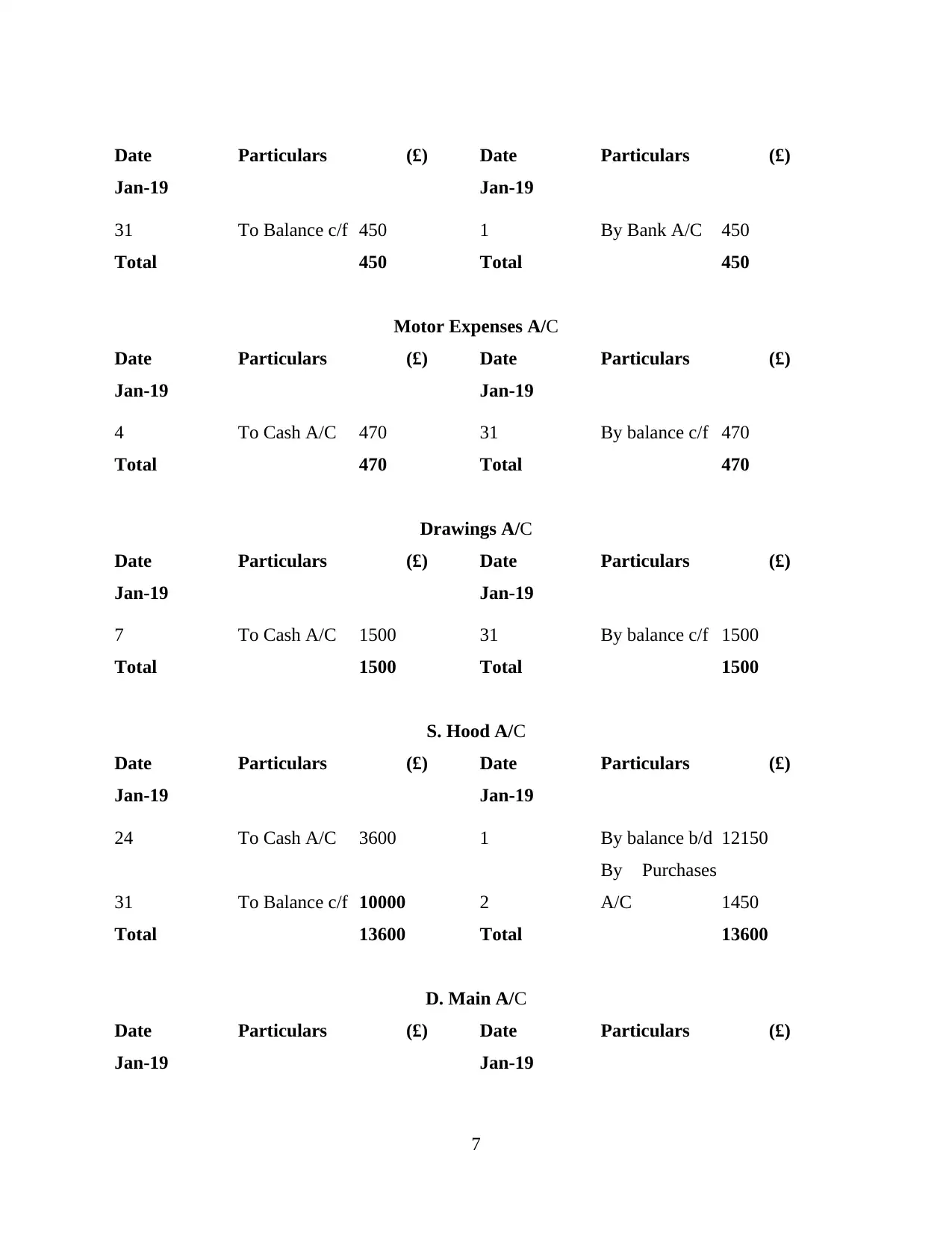
Date Particulars (£) Date Particulars (£)
Jan-19 Jan-19
31 To Balance c/f 450 1 By Bank A/C 450
Total 450 Total 450
Motor Expenses A/C
Date Particulars (£) Date Particulars (£)
Jan-19 Jan-19
4 To Cash A/C 470 31 By balance c/f 470
Total 470 Total 470
Drawings A/C
Date Particulars (£) Date Particulars (£)
Jan-19 Jan-19
7 To Cash A/C 1500 31 By balance c/f 1500
Total 1500 Total 1500
S. Hood A/C
Date Particulars (£) Date Particulars (£)
Jan-19 Jan-19
24 To Cash A/C 3600 1 By balance b/d 12150
31 To Balance c/f 10000 2
By Purchases
A/C 1450
Total 13600 Total 13600
D. Main A/C
Date Particulars (£) Date Particulars (£)
Jan-19 Jan-19
7
Jan-19 Jan-19
31 To Balance c/f 450 1 By Bank A/C 450
Total 450 Total 450
Motor Expenses A/C
Date Particulars (£) Date Particulars (£)
Jan-19 Jan-19
4 To Cash A/C 470 31 By balance c/f 470
Total 470 Total 470
Drawings A/C
Date Particulars (£) Date Particulars (£)
Jan-19 Jan-19
7 To Cash A/C 1500 31 By balance c/f 1500
Total 1500 Total 1500
S. Hood A/C
Date Particulars (£) Date Particulars (£)
Jan-19 Jan-19
24 To Cash A/C 3600 1 By balance b/d 12150
31 To Balance c/f 10000 2
By Purchases
A/C 1450
Total 13600 Total 13600
D. Main A/C
Date Particulars (£) Date Particulars (£)
Jan-19 Jan-19
7
⊘ This is a preview!⊘
Do you want full access?
Subscribe today to unlock all pages.

Trusted by 1+ million students worldwide
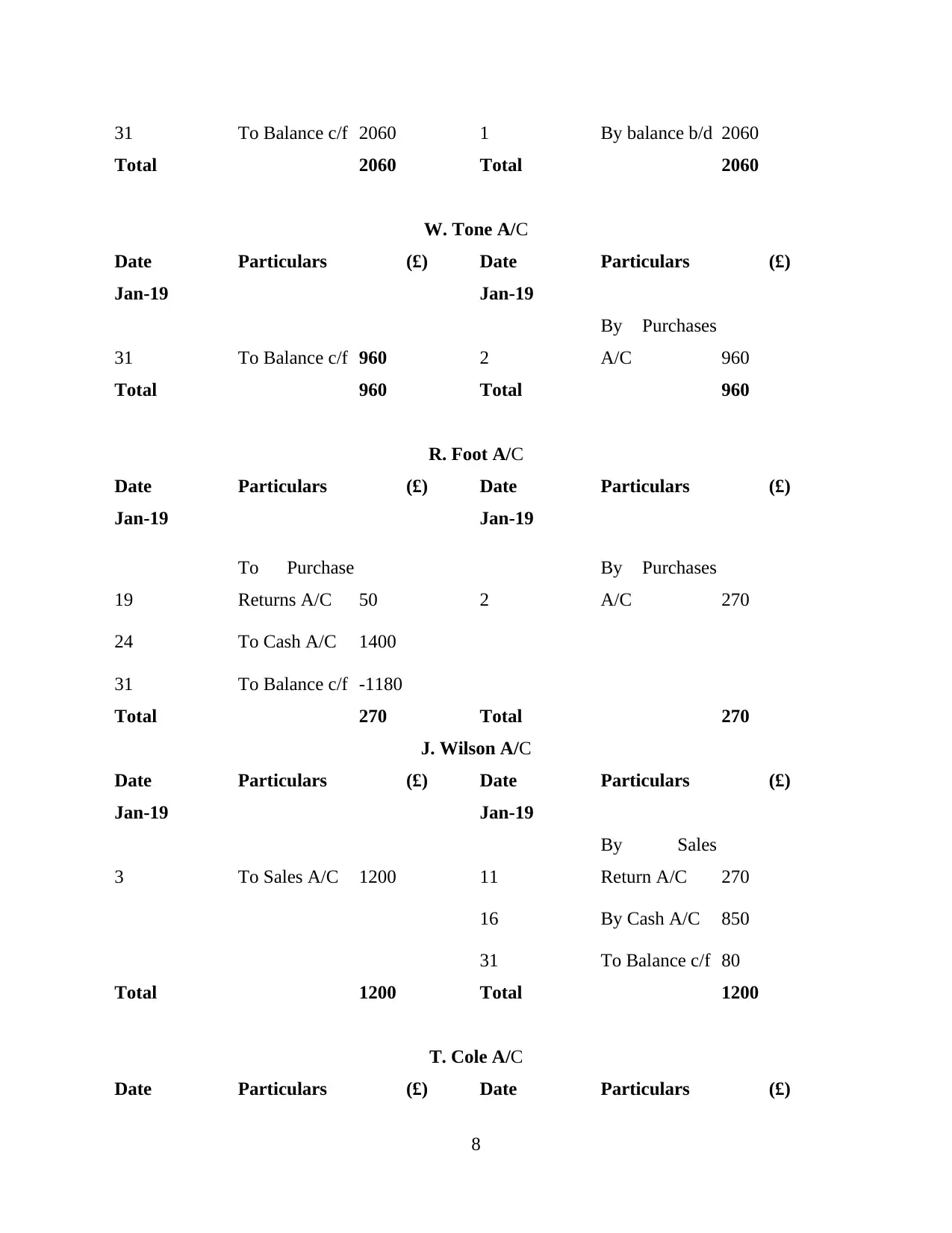
31 To Balance c/f 2060 1 By balance b/d 2060
Total 2060 Total 2060
W. Tone A/C
Date Particulars (£) Date Particulars (£)
Jan-19 Jan-19
31 To Balance c/f 960 2
By Purchases
A/C 960
Total 960 Total 960
R. Foot A/C
Date Particulars (£) Date Particulars (£)
Jan-19 Jan-19
19
To Purchase
Returns A/C 50 2
By Purchases
A/C 270
24 To Cash A/C 1400
31 To Balance c/f -1180
Total 270 Total 270
J. Wilson A/C
Date Particulars (£) Date Particulars (£)
Jan-19 Jan-19
3 To Sales A/C 1200 11
By Sales
Return A/C 270
16 By Cash A/C 850
31 To Balance c/f 80
Total 1200 Total 1200
T. Cole A/C
Date Particulars (£) Date Particulars (£)
8
Total 2060 Total 2060
W. Tone A/C
Date Particulars (£) Date Particulars (£)
Jan-19 Jan-19
31 To Balance c/f 960 2
By Purchases
A/C 960
Total 960 Total 960
R. Foot A/C
Date Particulars (£) Date Particulars (£)
Jan-19 Jan-19
19
To Purchase
Returns A/C 50 2
By Purchases
A/C 270
24 To Cash A/C 1400
31 To Balance c/f -1180
Total 270 Total 270
J. Wilson A/C
Date Particulars (£) Date Particulars (£)
Jan-19 Jan-19
3 To Sales A/C 1200 11
By Sales
Return A/C 270
16 By Cash A/C 850
31 To Balance c/f 80
Total 1200 Total 1200
T. Cole A/C
Date Particulars (£) Date Particulars (£)
8
Paraphrase This Document
Need a fresh take? Get an instant paraphrase of this document with our AI Paraphraser
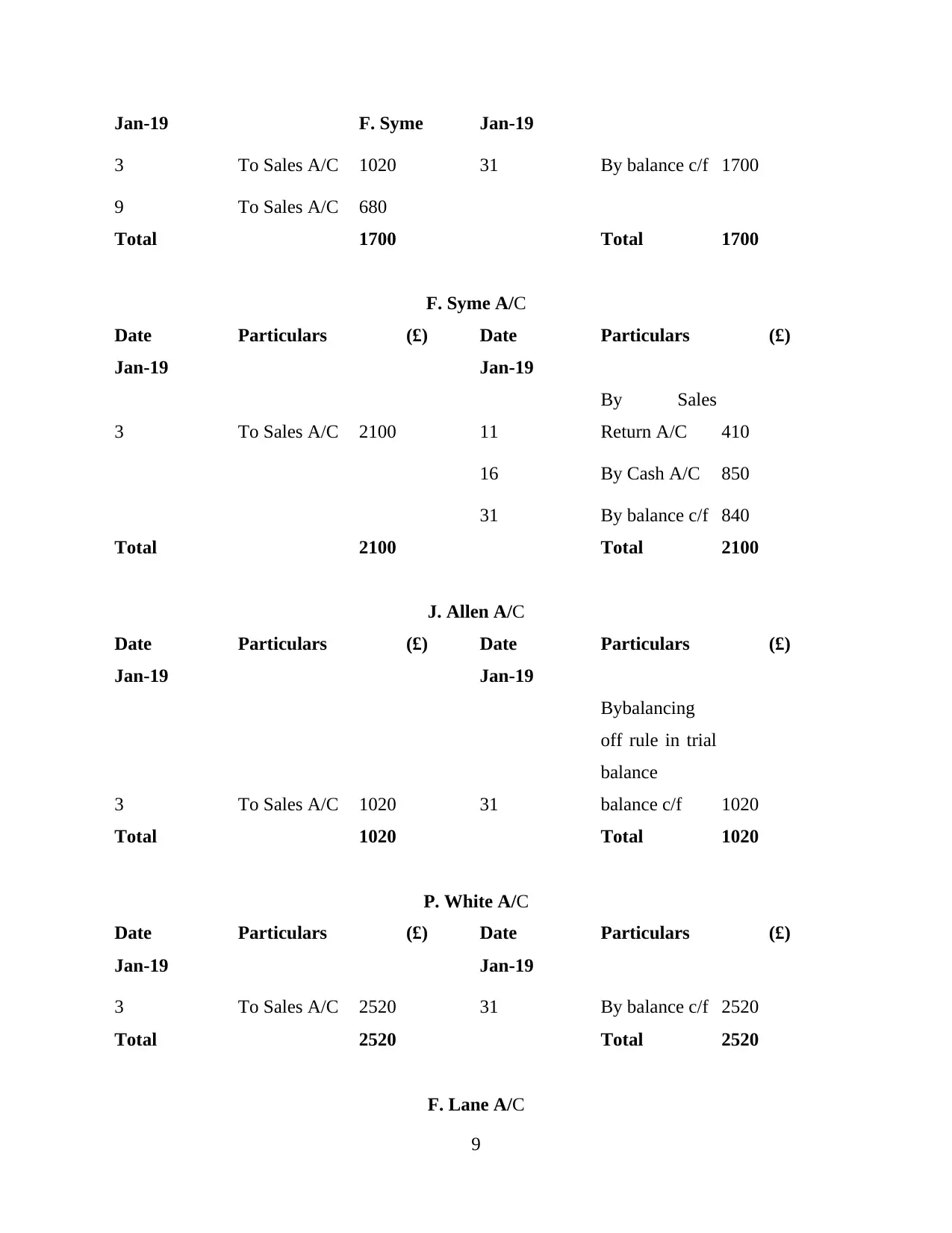
Jan-19 F. Syme Jan-19
3 To Sales A/C 1020 31 By balance c/f 1700
9 To Sales A/C 680
Total 1700 Total 1700
F. Syme A/C
Date Particulars (£) Date Particulars (£)
Jan-19 Jan-19
3 To Sales A/C 2100 11
By Sales
Return A/C 410
16 By Cash A/C 850
31 By balance c/f 840
Total 2100 Total 2100
J. Allen A/C
Date Particulars (£) Date Particulars (£)
Jan-19 Jan-19
3 To Sales A/C 1020 31
Bybalancing
off rule in trial
balance
balance c/f 1020
Total 1020 Total 1020
P. White A/C
Date Particulars (£) Date Particulars (£)
Jan-19 Jan-19
3 To Sales A/C 2520 31 By balance c/f 2520
Total 2520 Total 2520
F. Lane A/C
9
3 To Sales A/C 1020 31 By balance c/f 1700
9 To Sales A/C 680
Total 1700 Total 1700
F. Syme A/C
Date Particulars (£) Date Particulars (£)
Jan-19 Jan-19
3 To Sales A/C 2100 11
By Sales
Return A/C 410
16 By Cash A/C 850
31 By balance c/f 840
Total 2100 Total 2100
J. Allen A/C
Date Particulars (£) Date Particulars (£)
Jan-19 Jan-19
3 To Sales A/C 1020 31
Bybalancing
off rule in trial
balance
balance c/f 1020
Total 1020 Total 1020
P. White A/C
Date Particulars (£) Date Particulars (£)
Jan-19 Jan-19
3 To Sales A/C 2520 31 By balance c/f 2520
Total 2520 Total 2520
F. Lane A/C
9
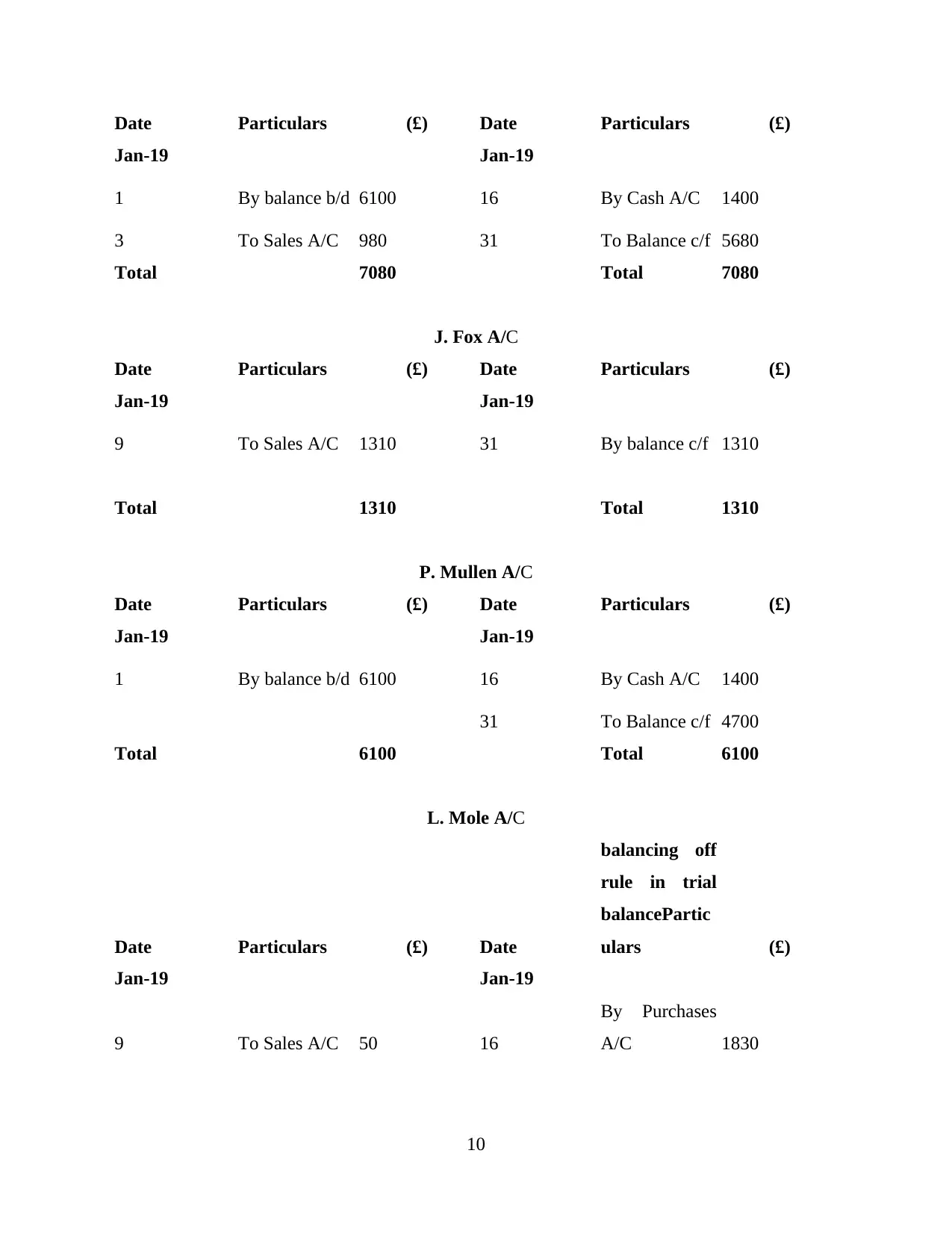
Date Particulars (£) Date Particulars (£)
Jan-19 Jan-19
1 By balance b/d 6100 16 By Cash A/C 1400
3 To Sales A/C 980 31 To Balance c/f 5680
Total 7080 Total 7080
J. Fox A/C
Date Particulars (£) Date Particulars (£)
Jan-19 Jan-19
9 To Sales A/C 1310 31 By balance c/f 1310
Total 1310 Total 1310
P. Mullen A/C
Date Particulars (£) Date Particulars (£)
Jan-19 Jan-19
1 By balance b/d 6100 16 By Cash A/C 1400
31 To Balance c/f 4700
Total 6100 Total 6100
L. Mole A/C
Date Particulars (£) Date
balancing off
rule in trial
balancePartic
ulars (£)
Jan-19 Jan-19
9 To Sales A/C 50 16
By Purchases
A/C 1830
10
Jan-19 Jan-19
1 By balance b/d 6100 16 By Cash A/C 1400
3 To Sales A/C 980 31 To Balance c/f 5680
Total 7080 Total 7080
J. Fox A/C
Date Particulars (£) Date Particulars (£)
Jan-19 Jan-19
9 To Sales A/C 1310 31 By balance c/f 1310
Total 1310 Total 1310
P. Mullen A/C
Date Particulars (£) Date Particulars (£)
Jan-19 Jan-19
1 By balance b/d 6100 16 By Cash A/C 1400
31 To Balance c/f 4700
Total 6100 Total 6100
L. Mole A/C
Date Particulars (£) Date
balancing off
rule in trial
balancePartic
ulars (£)
Jan-19 Jan-19
9 To Sales A/C 50 16
By Purchases
A/C 1830
10
⊘ This is a preview!⊘
Do you want full access?
Subscribe today to unlock all pages.

Trusted by 1+ million students worldwide
1 out of 21
Related Documents
Your All-in-One AI-Powered Toolkit for Academic Success.
+13062052269
info@desklib.com
Available 24*7 on WhatsApp / Email
![[object Object]](/_next/static/media/star-bottom.7253800d.svg)
Unlock your academic potential
Copyright © 2020–2025 A2Z Services. All Rights Reserved. Developed and managed by ZUCOL.




